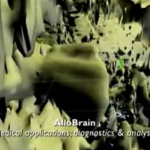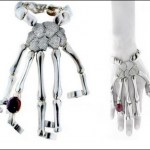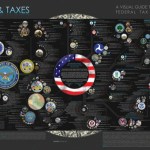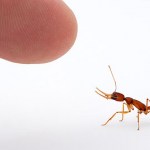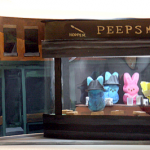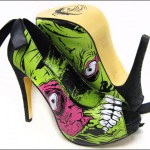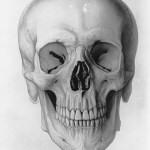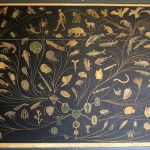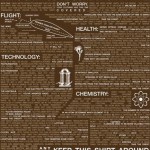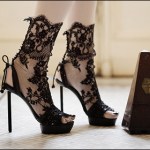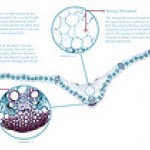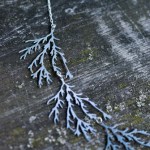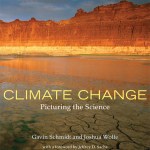
In her recent TED talk, JoAnne Kuchera-Morin described UCSB's AlloSphere, a new project that enables scientists to literally stand inside a three-story projection of their data:
The AlloSphere space consists of a 3-story cube that is treated with extensive sound absorption material making it one of the largest anechoic chambers in the world. Standing inside this chamber are two 5-meter-radius hemispheres constructed of perforated aluminum that are designed to be optically opaque and acoustically transparent. (source)
Scientists and artists can stand on a bridge through the center of this…
Jewelry designer Delfina Delettrez is young, a fourth-generation member of the Fendi family, and apparently obsessed with anatomy. Her most intriguing creation is a Skeletor-like carpal gauntlet:
The silver hand will cost you about $24K. If you haven't got that much disposable income, she also does smaller pieces: earrings and necklaces inspired by eyes, lips, spiders, cephalopods, frogs, etc. They're pretty, but I keep coming back to that hand and thinking it's so cynically appropriate to put a bony skeleton hand on a fashion model.
Found via haute macabre
You've never heard "in real time" screamed with so much passion. Not just one, but two big-haired metal-band bio-rock videos after the fold. . .
(sources: here and here)
This chart shows where your federal tax dollars go, based on Feb 2008 budget numbers (note: this shows discretionary budget, or appropriations, only - go here for more details, or look at the inset in the lower right corner to see where the other two-thirds of the budget are).
Visit wallstats.com for a giant version.
If you enjoy bioephemera, you should take a moment to check out Scienceblogs' new blog, Photo Synthesis:
While doing our usual browsing of the blogosphere, we've become aware of the vast number of excellent blogs featuring science imagery, from neural networks captured with a light microscope to images of supernovae billions of light-years away. To take advantage of this wealth of visual content, we've decided to host our favorites here on ScienceBlogs, with a rotating line-up of photobloggers we'll select monthly.
This month, Alex Wild of myrmecos kicks things off with his insect…
No, it's not how evolution really works, but it's awfully cool anyway.
The Experiment from Colin Trenter on Vimeo.
I love Photoshop, but am I the only one who thinks this resembles a cross between a Rorschach test and a SyFy Channel commercial?
As I put it at a blogging panel last fall, "in science, it is normative to be not sure." It wasn't my most eloquent moment, but at least AAAS' president-elect Alice Huang agrees with me that one of the biggest challenges to public science literacy is understanding the contingent nature of scientific "truth".
But probably the most difficult concept to get across to nonscientists is that we look at data and then use probabilities to judge those data. The public wants an absolute black-and-white answer. We may look at something that is 80 percent likely as being good enough to base decisions on…
NightPeeps
Melissa Harvey (after Edward Hopper)
It's that time of year again! As I roasted blue Easter Peeps over the gas stove yesterday, I eagerly awaited this year's collection of Peep dioramas from the Washington Post - and here they are! View the complete Peeps Show here.
Be sure to check out "Double Peep Strike" (Miracle on the Hudson), Bernard Peepoff, and the Trek Peeps of Stardate 2351.6. Many dioramas play on DC themes: "Peep to the Right" refers to clueless tourists who stand on the left side of Metro escalators, blocking those of us who use public transit to get to work; "…
Zombie Stomper by Iron Fist, via Haute Macabre
Yup - Abraham Lincoln, Vampire Hunter is the project the author of Pride and Prejudice and Zombies is doing next. While my review of P&P&Z was pretty positive, I'm not sure I can in good conscience encourage this trend.
Also, note that while P&P&Z has surged to the top of the bestseller list, the New Yorker was not as charitable in its review as I was. Perhaps these shoes by Iron Fist might serve as a litmus test for whether you are likely to enjoy P&P&Z. Tongue-in-cheek fun or thoroughly foul? You be the judge!
This detailed medical illustration by the late Duncan Winter shows the advantages of a good medical illustration over a typical photograph. There are no problems with over- or under-exposure, no depth-of-field issues, and the salient features are subtly emphasized. The underside in particular is very impressive work - there's a lot going on down there and it's really tough to draw clearly.
From the medical illustration flickrset by Bottled Monsters
This beautiful painting is located in Martin Hall at Swarthmore College. Discovered via Colin Purrington's flickr feed.
Here's one perspective on why journalism training is a bad idea:
I like to joke that I'm "unqualified" to do my job. But I think it was precisely that total lack of journalism training that gave me an edge. I never worked the cops-and-courts beat. I don't know how to write an inverted pyramid story or even really what that is. I do know how to write for different platforms, be scrappy and break news. I've had zero important alum connections and never got an internship at a big daily. And, in hindsight, that's probably the greatest stroke of luck I could have had. Journalism schools are like…
Say you end up transported back in time, you can read English, and you're still on Earth: this T-shirt is your crib sheet for a successful career as visionary, inventor, and entrepreneur! Either that, or it will get you burned as a witch.
View larger here.
Wear/read/implement at your own risk. . .
Last night, I dreamed that I had a closet full of seriously amazing shoes, from strappy stilettos to lace-up boots. When I awoke and remembered that my closet is actually full of uncomfortable work pumps and trail runners, I was disappointed. But I knew who to blame for my dream: Isis!
Ever since Isis arrived at Scienceblogs, I've been meaning to post something about shoes. When our resident domestic and laboratory goddess saved me a couple hours of driving to and from the office on Saturday by emailing me a journal article I'd forgotten, I promised to write her a thank-you post all about…
Zea Poster from m f's flickr stream
Michael Franklin, Rochester Institute of Technology
One of the ways in which I can foresee Web 2.0 applications changing the culture of science is by increasing avenues for mentorship. Web apps allow students from different departments, universities, and nations to connect, collaborate, and exchange advice. This can mean career-changing help for students at small institutions (or for those at large institutions with poor interdepartmental relations or a dearth of experts in a particular field). I'm not just talking about help troubleshooting protocols; far…
Algae filament necklace
Pam at Phantasmaphile alerted me to Nervous System, a jewelry company founded by MIT grads Jessica Rosenkrantz and Jesse Louis-Rosenberg. Nervous System "creates experimental jewelry, combining nontraditional materials like silicone rubber and stainless steel with rapid prototyping methods. We find inspiration in complex patterns generated by computation and nature."
While their various lines don't look quite as I expected - I was anticipating something Haeckel-like for "radiolaria" and neuronal for "dendrite" - they are intriguing and definitely "feel" organic.…
I find this 1950s-era needle book cover fascinating, because it mixes the stereotypically female activity of sewing with the stereotypically male interest in space travel. What is the connection here? Are these young women sewing spacesuits? Are they inspired by/chatting about the excitement of rocket science? Is there any tenuously plausible connection that can be made between a space ship named "The Moon" and sewing needles, other than that they are both silver?
View larger image
Ha! It turns out we can't even make that connection, because a closer look at the packaging reveals that the…
There are two interdisciplinary science meetings coming up that you should consider attending, in NYC and DC. Strangely enough, the ubiquitous Chris Mooney is speaking at both of them. Hmmm.
From April 30-May 1 in DC will be the AAAS Forum on Science and Technology Policy, which is a somewhat wonky look at federal science policy and government affairs. The agenda highlight? A plenary session on the future of science journalism, to which I'm looking forward with both enthusiasm and curiosity, given the wide range of opinions on the blogosphere. I'm sure there will also be lots of discussion…
Scibling Bora has expressed his wish "to end once for all the entire genre of discussing the "bloggers vs. journalists" trope," and tried to do so with perhaps the most massive science-journalism-Web2.0 post evah.
Bora says,
the whole "bloggers will replace journalists" trope is silly and wrong. No, journalists will replace journalists. It's just that there will be fewer of them paid, and more of us unpaid. Some will be ex-newspapermen, others ex-bloggers, but both will be journalists. Instead of on paper, journalism will happen online. Instead of massaging your article to fit into two inches…
This Tuesday, April 7, the Koshland Science museum in DC is hosting a book talk:
Join NASA scientist Gavin Schmidt and accomplished photographer Joshua Wolfe as they demonstrate how photographs can illustrate the effects of global warming more poignantly than any temperature graph or chart. The two will show photos and satellite images of retreating glaciers, sinking villages in Alaska's tundra, and drying lakes from their new book, Climate Change: Picturing the Science. They will also discuss how scientists gather climate data and come up with cutting-edge research findings.
RSVPs are…
